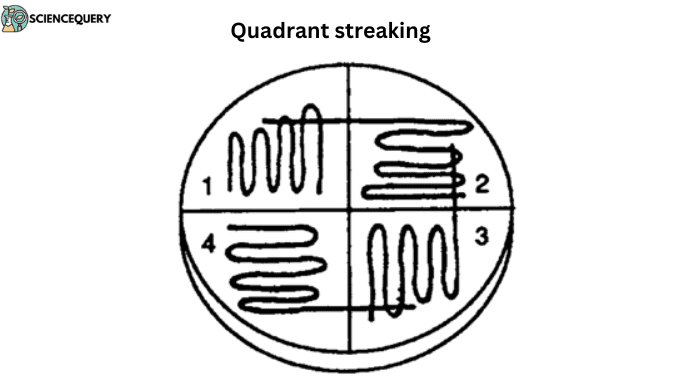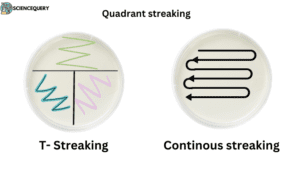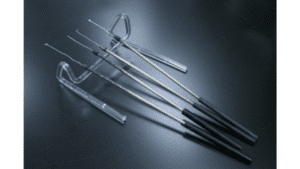
Introduction
Quadrant streaking is a highly used method by biologists to obtain a pure culture by the inoculation of certain microorganisms. Here, the agar plate is quadrantal streaked i.e., divided into four equal sections. Hence, it is also called the 4 Quadrant Streak.
Streaking is done to obtain a pure culture and identification of microorganisms.
Importance of quadrant streaking

Quadrant streaking is one of the most used streaking procedures in obtaining a pure culture. It helps in isolating a single colony from the mixed culture. There are several types of streaking patterns:
- T- streaking
- Continuous streaking
- Zigzag streaking
- Quadrant streaking
- Radiant streaking
- Semi-quantitative streaking
Material and equipments

-
Agar plant media
Agar media are prepared with Tryptic Soy Agar (TSA) enriched with yeast extract to promote the growth of a broad range of organisms.
-
Inoculating loop
Inoculating instruments must be sterilized before use. The loops and inoculating needles are immediately sterilized before use. The sterilization is done through a Bunsen burner flame.
The mouths of tubes and flasks containing cultures or media are also burned up (slightly heated at the mouth area) while passing their openings by a flame.
They are used to transfer a microbial sample, the choice of which depends on the sample source, its destination, and any special requirements imposed by the specific protocol.
-
Needles
They are the commonly used microbiological tools for transferring microbe culture in all media types including broths, slants, and plates.
-
Incubator
It is an insulated instrument extensively used in laboratories. It helps in creating optimum environmental conditions that are necessary for the growth of microorganisms at optimum temperatures.
Procedure
Quadrant streak
Preparation of bacterial inoculum
Quadrant streak is a style of streaking for isolated single colonies of microorganisms on a solid medium which entails dividing the plate into four areas or quadrants. This method is used for cells having high densities.
Inoculum is a method of introducing cells to activate a microbial culture.
Agar plates are media used for the growth of bacteria and microorganisms. Nutrient Agar is used for the growth of bacteria.
Broth culture allows bacterial growth in a liquid growth medium.
First streak
- The inoculum is settled at the first quadrant in agar plate media.
- The first quadrant demonstrates a tight streak, as most of the growth takes place in this quadrant.
- The petri dish needs to be labeled before the process. The loop needs to be sterilized before use. Heat the loop in a flame till a hot red point to remove any sample contamination.
- Then take a loopful of colony culture from the already prepared sample or broth.
- Now apply the culture with the loop slowly by streaking back and forth, like a zig-zag pattern.
- Cover the lid and let it stay in the laminar flow.
- Sterilize the inoculation loop.
Second streak
- Start again by dragging the inoculation loop from the first quadrant, followed by the intersection.
- Cover the petri dish to lower the risk of contamination.
- Now again sterilize the loop and invert the petri plate at an angle of 90 degrees.
- The streaks need to be continuous to show a good growth culture.
Third streak
- Proper sterilization of the loop is needed to avoid contamination of the sample.
- Put the inoculation loop in the flame. Shift the plate again to 90 degrees in the same direction.
- Touching from the second quadrant, continue streaking in the third quadrant.
Fourth streak
- Again after loop sterilization, Streak the bacteria count the third quadrant into the fourth in the space left till middle.
Interpretation and Evaluation
Quadrant streaking is a process of analyzing the results. It includes data interpretation points on a graph and connecting them to identify similar patterns. This process is to evaluate data types such as biochemical experiments.
Quadrant streaking allows biologists to calculate results through visuals that are easier to understand. Moreover, it also allows comparison between different data of species, helping in understanding concussions.
Applications
Quadrant streaking is a useful lab method of identification of pure culture. It includes applications like :
1. Identification of microbial colonies on agar petri plates – The four-method streak is used in the identification of bacterial count in a colony of various species, and its characterization of other unknown microorganisms.
2. Isolation of microbes through specific enzyme activities – With the help of the quadrant streak method, like patching, variants are isolated from a single bacterial colony within a short span.
3. Screening of antibiotic resistance in pathogenic microorganisms – Quadrant streaking allows scientists to detect numerous antibiotics against specimens grown in an environment containing particular antibiotic agents at possible concentrations.
Problems with Quadrant streaking
- It is a method of qualitative isolation and is time-consuming. It does not allow the quantification of microbes.
- High probability of contamination as the plate is opened repeatedly.
- There is a chance of insertion of a loop into the agar media that can destroy the microbes, enabling low culture growth of microorganisms.
- As the sample is diluted, the number of microorganisms decreases in the third and fourth quadrants.
- Uneven distribution of streaking won’t show any microbial growth and the desired results will not be obtained.
Alternative of Quadrant Streaking
T-streak can be considered as an alternative to quadrant streaking. It is divided into three quadrants and a discontinuous method of isolation of bacterial colonies. The streaking style is very similar to the alphabet T.
Q&A
1. What is Quadrant Streaking?
Quadrant streaking is one of the most used streaking procedures in obtaining a pure culture. It helps in isolating a single colony from the mixed culture.
2. What are the 4 types of streaking methods?
There are basic four types of streaking patterns:
T- streaking
Continuous streaking
Quadrant streaking
Radiant streaking
3. What is the technique of quadrant streaking used in microbiology?
The inoculation technique is done as the first streak for the identification of more than one bacterial species in a mixed culture with a percentage involving high cell density.
- Draw quadrants on the outside bottom of an agar petri plate using a marker. This will enable perfect identification of the quadrant.
- Heat the loop till red hot in the Bunsen burner flame to avoid contamination. Cool down the loop temperature and then allow it into the broth culture. High temperatures kill the bacteria and will not produce any positive results.
- Touch the loop end to the upper surface of the agar carefully and extend it gently in the first quadrant in a continuous streaking fashion.
- Use the petri dish cover to protect the agar surface and prevent contamination from falling onto the medium. Avoid direct penetration of the inoculation loop into the agar.
- Sterilize the loop, and again streak from the previous area to the second quadrant.
- Sterilizing the inoculation loop is extremely necessary as it kills the previous scale microbes and is free from any contamination.
- The same steps are repeated in the second, third, and fourth quadrants.
- Flame the loop in the burner after finishing all the steps.
4. What is the difference between a quadrant streak and a spread plate?
The major difference between a quadrant and a spread plate technique is that a spread plate is a method where inoculum is put on the solidified agar media. They are highly used in the isolation of various colonies that occur on the surface of the plate.
In the quadrant streak, only a single colony is isolated with the help of a sterilized inoculation loop. The quadrant streak is done in four different quadrants to obtain a pure culture growth of microorganisms.
Summary
- Quadrant streaking is one of the most used streaking procedures in obtaining a pure culture.
- It helps in isolating a single colony from the mixed culture.
- It is also termed as Four quadrant streak.
- T-streak can be considered as an alternative to quadrant streaking. It is divided into three quadrants and a discontinuous method of isolation of bacterial colonies.
- The four types of streaking patterns include T-T-streaking, Continuous streaking, Quadrant streaking, and Radiant streaking.
- The four-method streak is used in the identification of bacterial count in a colony of various species, and its characterization of other unknown microorganisms.
- With the help of the quadrant streak method, like patching, variants are isolated from a single bacterial colony within a short span.
- This method is used for cells having high densities. Inoculum is a method of introducing cells to activate a microbial culture.
- Quadrant streaking allows scientists to detect numerous antibiotics against specimens grown in an environment containing particular antibiotic agents at possible concentrations
- The first quadrant demonstrates a tight streak, as most of the growth takes place in this quadrant.
- Streaking is done to obtain a pure culture and identification of microorganisms.
References
- https://onlinelibrary.wiley.com/doi/abs/10.1111/jfs.12311
- https://journals.asm.org/doi/abs/10.1128/JCM.41.1.242-249.2003
- https://academicjournals.org/journal/IJLP/article-full-text/3EE6E8B53585
- https://asm.org/ASM/media/Protocol-Images/The-Streak-Plate-Protocol.pdf?ext=.pdf
- https://onlinelibrary.wiley.com/doi/abs/10.1111/jfs.12311
